
Germany - diesel locomotives of DB AG and DB Cargo
For a full scale picture, please click on the picture shown !
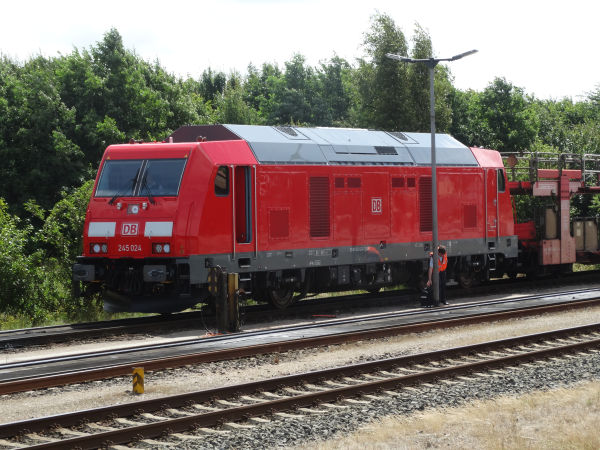
This is some of the very newest diesel traction power of DB.
It is a Bombardier TRAXX diesel of Br 245. It has four engines and it can use just some of them or all of them
at the same time depending on the need. Here the locomotive is seen pulling a car train of the "Sylt Shuttle",
which links the town of Westerland located on the island of Sylt to mainland at Niebüll. There is no road from
the island to the mainland, but only a train line and a ferry. Picture at Niebüll station 9.7.2016 by Ilkka Siissalo.
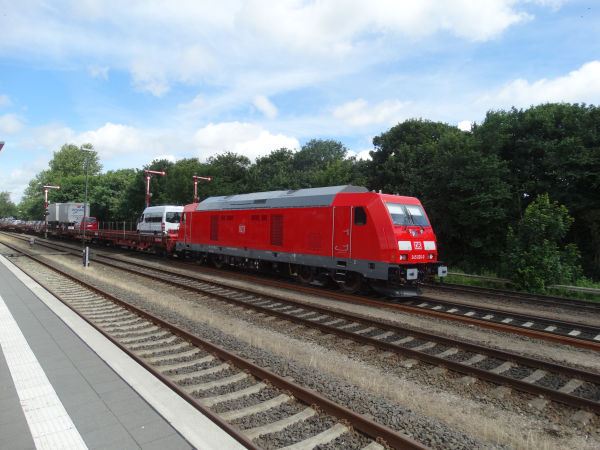
A "Sylt Shuttle" car shuttle train is arriving from the island of Sylt to the station of Niebüll on the mainland.
The locomotive is a brand new Br 245 multiple engine TRAXX diesel.
Picture from Niebüll 9.7.2016 by Ilkka Siissalo.
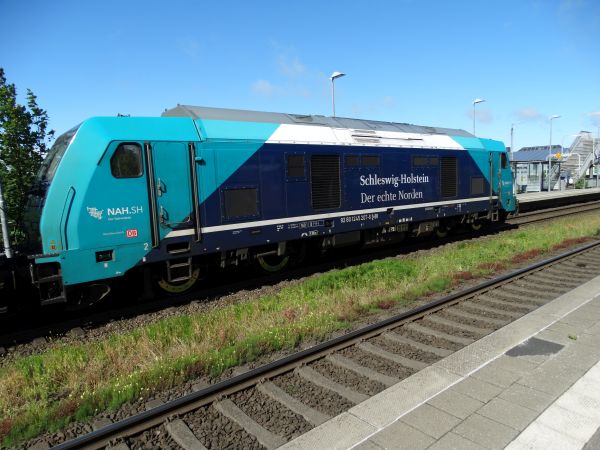
Roughly at the same time when DB bought its Br245 diesel machines shown above, also the Bundesland of
Schleswig-Holstein bought similar Br245 locomotives. They were painted in the colours of the land and were
first operated by NOB,a subsidiary of Transdev. But then there was a renewed tendering process and Transdev
lost that business. The locomotivs remain in the Bundesland colours but have now small DB stickers.
Picture from Klanxbüll station 8.7.2022 by Ilkka Siissalo.
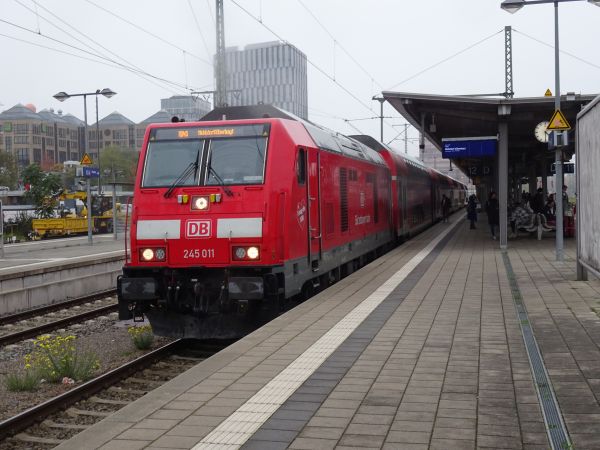
A Br 245 diesel TRAXX in front of a Regionalexpress train to Mühldorf.
Picture from München Ostbahnhof 14.10.2022 by Ilkka Siissalo.
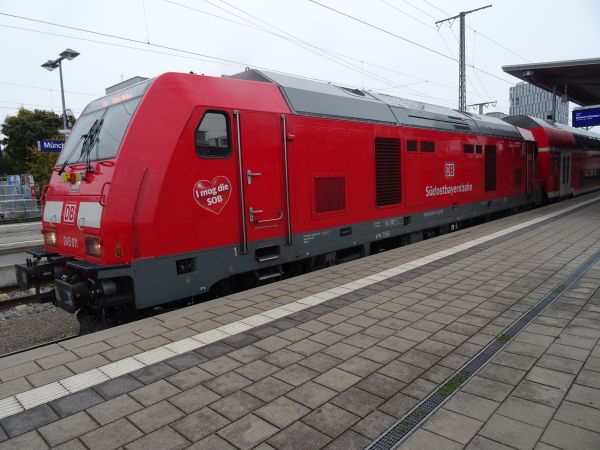
The same Br 245 diesel as above but now seen from a bit closer by.
Picture from München Ostbahnhof 14.10.2022 by Ilkka Siissalo.
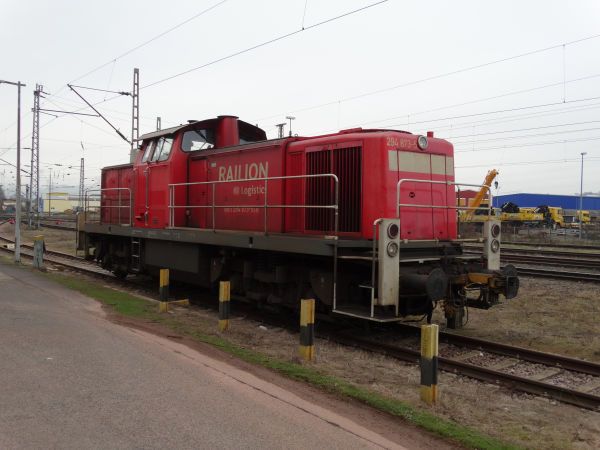
The class 294 is old, but still quite common in shunting yards throughout Germany. Gradually they are being replaced by
newer machines.
Picture from Trier 18.12.2016 by Ilkka Siissalo.
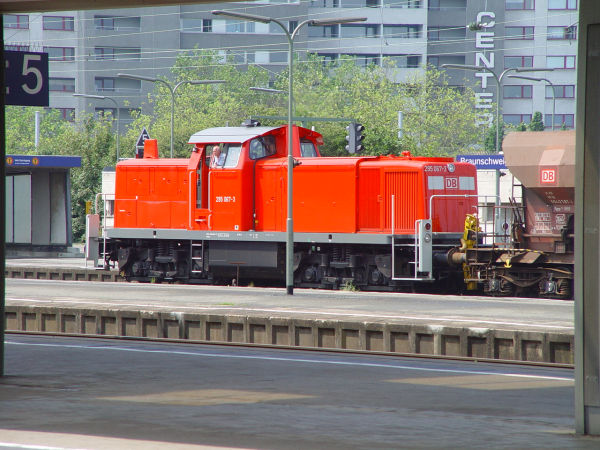
This is a Br 295 machine right after a thorough rehaul. It is one of the same machines also known as V90 or as Br 294 as seen above,
with the only main difference being that now it has a new engine and now it can be remotely controlled from a wearable fairly small
device, so the locomotive driver does no more have to be inside the locomotive. Notice the fairly large upward protruding red antenna
on the left hand side of the locomotive. That is the sign of the radio remote controlling system.
Picture from Braunschweig Hbf 22.7.2004 by Ilkka Siissalo.
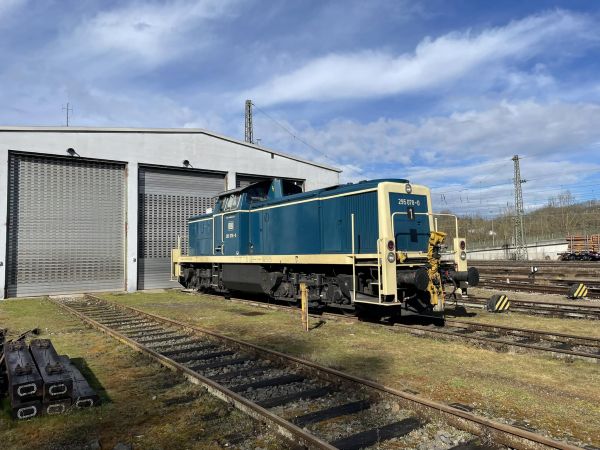
This Br295 machine had after a thorough overhaul been repainted in the historic colourings it used to have in the 1970s.
Picture from Passau by Michal Makalouš 10.3.2023.

These Br261 Voith Gravita 10 BB diesel locomotives are new and they are gradually replacing the old V90 series locomotives
like the Br294 pictured above. These are mainly used for shunting, but also on longer lines with light or medium-heavy cargo
trains.
Picture from Hamburg Alte Süderelbe 14.7.2019 by Ilkka Siissalo.
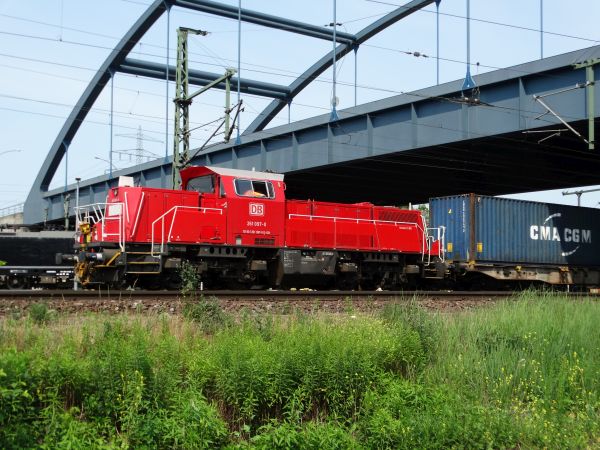
Another Br 261 Gravita machine, here pulling a heavy container train from a more remote part of the Hamburg harbour into the
big rail yard Süederelbe.
Picture from Hamburg Süderelbe 9.7.2023 by Ilkka Siissalo.
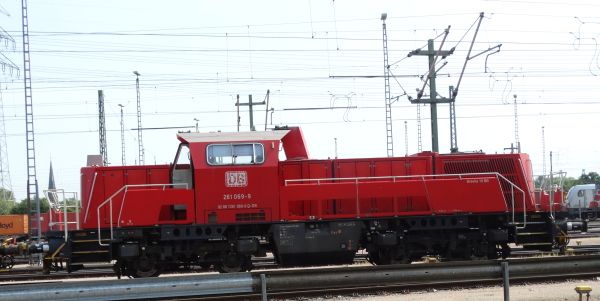
A closer look at one of the Br261 Gravita 10 BB machines.
Picture from Hamburg Alte Süderelbe 9.7.2023 by Ilkka Siissalo.
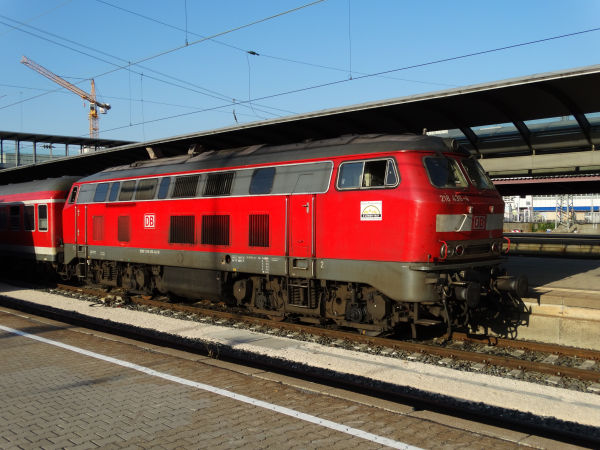
The old diesel locomotive class of V160, currently classes 210, 215, 216, 217, 218 and 225 used to be extremely common
throughout Germany. These are 1960s diesel engines. Many have already been scrapped, but it is still possible to see
some in daily use, like here a Br 218 machine with old "n-Wagen" or "Silberling" coaches. The painting is new, but otherwise
this is pure 1960s - 1970s stuff. Picture at Ulm station 13.9.2016 by Ilkka Siissalo.
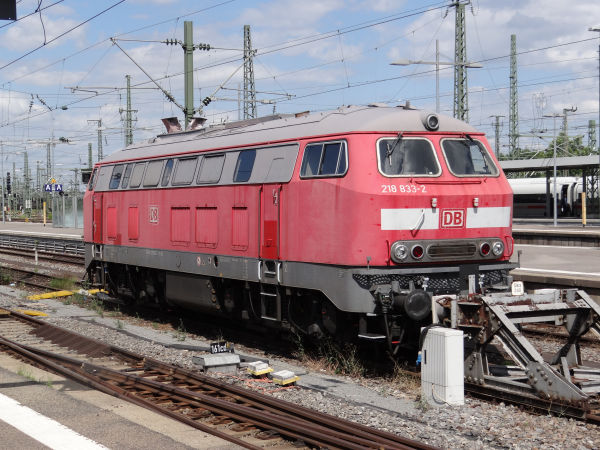
It's old, it's weak, it's ugly, but it's still there. A Br 218 at Stuttgart Hauptbahnhof 8.7.2015. Picture by Ilkka Siissalo.
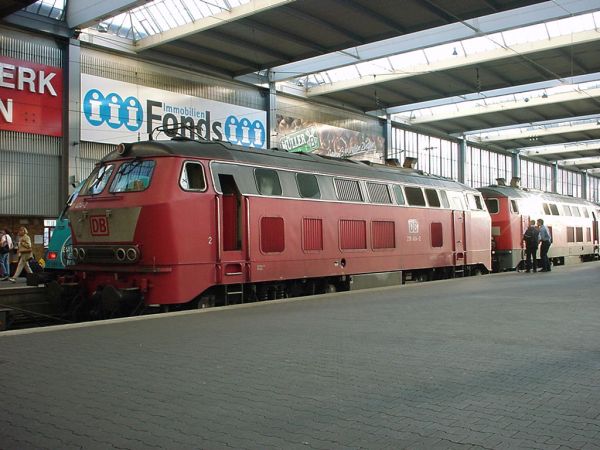
Here we see one of the Br 218 machines still in its "Orientrot" (oriental red) painting scheme. Most locomotives lost this livery
by the end of the 1990s.
Picture from München Hauptbahnhof (Munich main station) 14.6.2002 by Ilkka Siissalo.
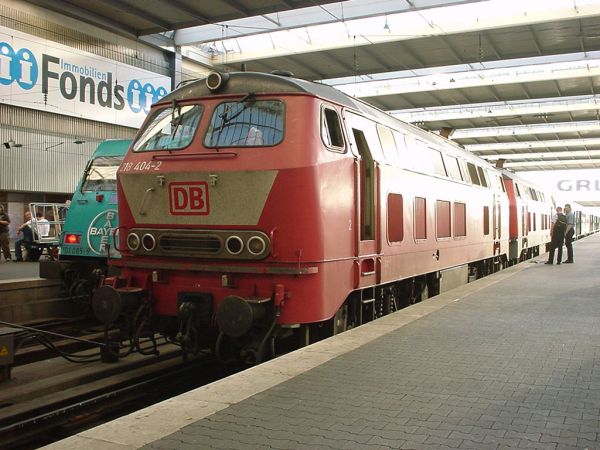
The same "orientrot" Br 218 as above, now seen from its front.
Picture from München Hauptbahnhof (Munich main station) 14.6.2002 by Ilkka Siissalo.
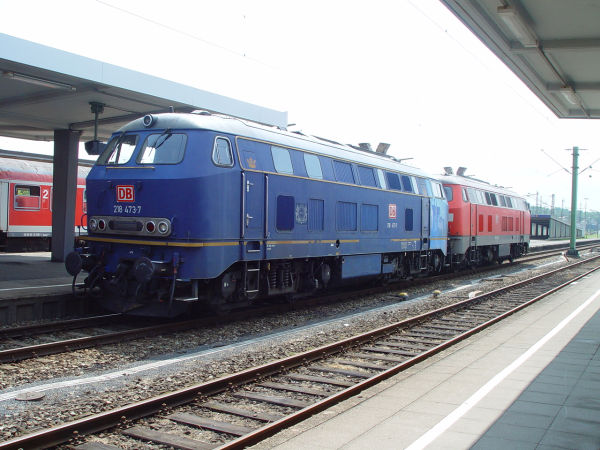
In 2001 the model train manufacturer Märklin repeated again one of their old tricks. They made a deal with DB and got a permission to paint
one of DB's old Br 218 locomotives dark blue. They added a couple of stickers with golden crowns, a couple of golden stripes and renamed
the old thing "König Ludvig Lok", king Ludvig locomotive. At one end of the machine there was a large light blue sticker which depicted
the famous Neuschwanstein medieval castle. And the trick was done. Then Märklin could produce a large batch of these Br 218 machines and
sell them again to people who had already their Br 218 models. Now they would buy one more of these machines that otherwise nobody would
want any more.
The "König Ludvig Lok" was introduced during the so called "Märklin Days" at Märklin's headquarters 5.5.2001. Here the same machine 218 473
was photographed along with another Br 218 machine at Braunschweig Hbf 22.7.2004. The colours had faded away, somebody had torn off the
Märklin stickers but it was still recognizable after such a long time.
Picture from Braunschweig Hbf 22.7.04 by Ilkka Siissalo.
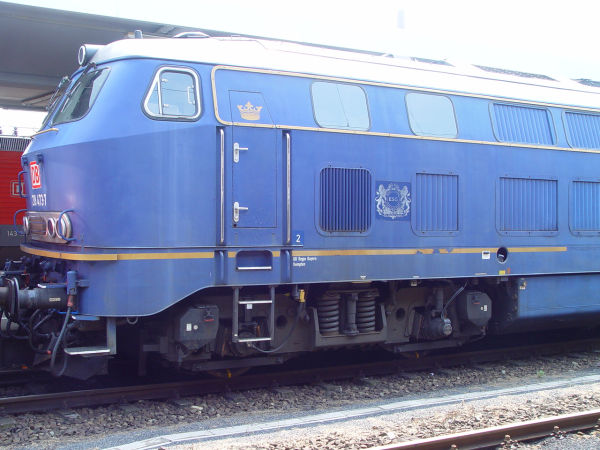
A detail picture of the front of the "König Ludvig Lok" Br 218 no. 473.
Picture from Braunschweig Hbf 22.7.04 by Ilkka Siissalo.
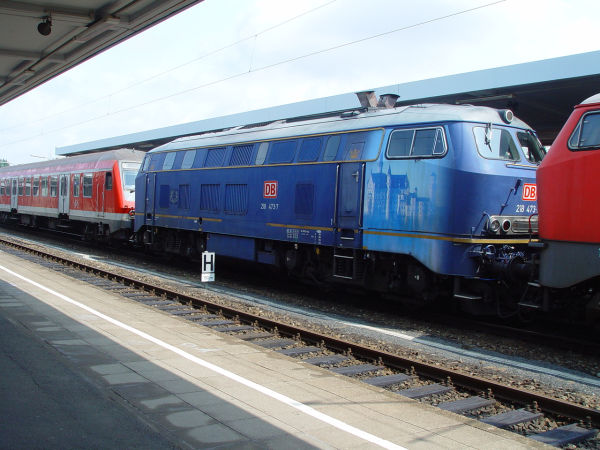
The light blue faded away ghostly picture of the famous Neuschwanstein castle looked quite pitiable already in 2004 at the rusty side of the
"König Ludvig Lok" Br 218 no. 473.
Picture from Braunschweig Hbf 22.7.04 by Ilkka Siissalo.

This is DB in disguise. The modern big diesel machine which is here being towed behind a DB Br185 electric locomotive is a US built
class 77 machine designed for use in Britain. The machine is marked as belonging to "Euro Cargo Rail". Germany and the Germans are
still fairly much hated in France and Belgium, so DB operates in those countries often via the trademark name Euro Cargo Rail, which
is considered to be more neutral than DB's well known red. And ECR's locomotives are also often loaned by the parent company DB for use in
Germany. They have for example often replaced old Soviet made "Ludmilla" diesels of Br232/Br233/Br234 in hauling heavy cargo trains.
Class 77 is known by DB in Germany as Br247. It's a US machine, built by EMD and it's a further development of an earlier and very
similar looking machine called class 66. They are quite cheap and are therefore gaining popularity, although train drivers hate them
for being too noisy and cold.
Picture of a class 77 locomotive being towed 16.7.2018 by the Coswig station near Dresden. Picture by Ilkka Siissalo.

A class Br203 locomotive passing Wolfsburg Hbf. This machine belongs to the DB Netz Instandhaltung, the rail tracks maintenance division of DB.
This is one of the former East German so called V100 East locomotives, which after the reunification of the two German states are known as Br202, 203 or 204
depending on the engine installed. This communist East German locomotive type was quite successful and even today a lot of them are in use, especially
remotorised and by small private companies. But as here, even DB uses many of them still today.
Picture from Wolfsburg 17.7.2018 by Ilkka Siissalo.
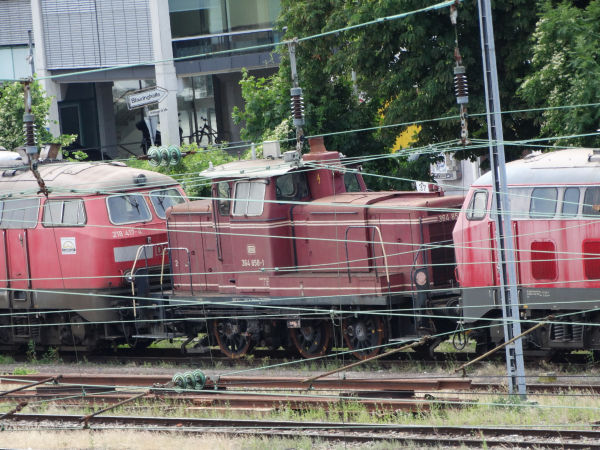
This old locomotive marked Br364 is a former Deutsche Bundesbahn V60 shunter from the mid-1960s. They are still very common in Germany, but this one, owned by
the DB subsidiary RAB ZugBus, has again been painted in its original 1960s colours, bearing also the 1960s style logos on its sides.
Picture from Ulm 3.7.2019 by Ilkka Siissalo.
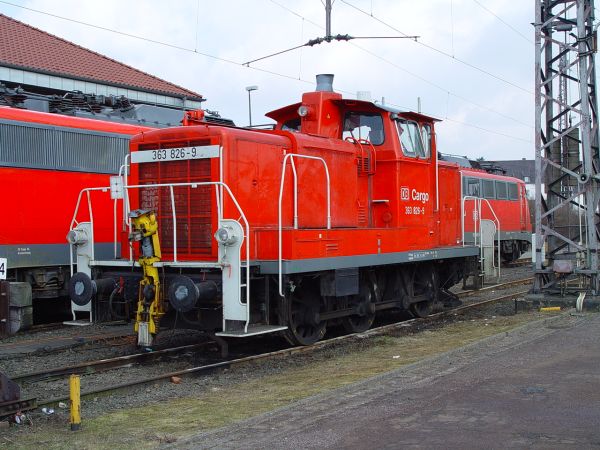
This class Br363 locomotive is one of the same old Deutsche Bundesbahn V60 machines dating back to the 1950s. The series number 363 tells us that this one is
remotorised with a Caterpillar engine. There were originally 942 V60 locomotives produced and out of those still several hundred are in active use, but they
have now been split into many different Baureihe-numbers according to their history.
Picture from Osnabrück 1.3.2003 by Ilkka Siissalo.
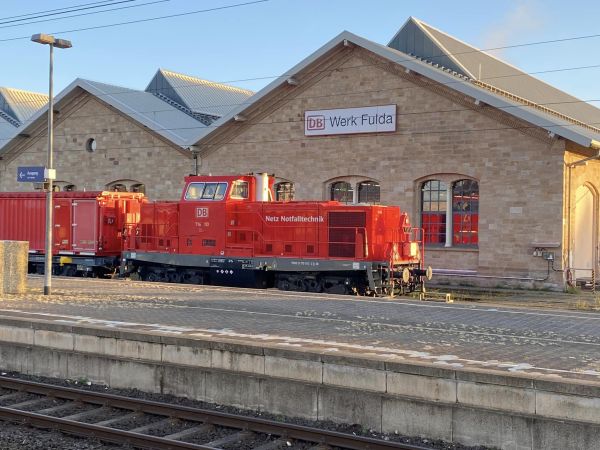
This Br714 diesel locomotive may look quite familiar to anyone who knows old Deutsche Bundesbahn machines from the 1960s or 1970s. It is indeed a totally
rebuilt Bundesbahn V100 which has gotten a new life as a specialised locomotive of a rescue train. Two of these are used in sandwich style to motorise
rescue trains for the new fast ICE tracks in mountainous areas with a lot of tunnels, just in case there would be an accident or breakdown in a tunnel.
One of these rescue trains is always ready at the station of Fulda and this is one of the two Br714 machines that belong to it.
Picture from Fulda 11.10.2022 by Kevin Prince.
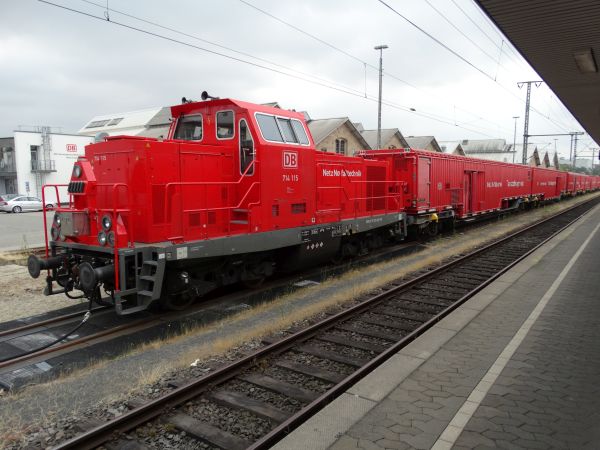
A better picture of the same tunnel rescue train as shown above. Note its totally rebuilt old DB V100 diesel locomotives which are now being called Br714. Despite
the total rebuilding, there are still some details left which reveal that this is in fact an old 1960s V100 machine. Note also how the wagons of the rescue train
have been designed so that the doors of the wagons are very low down. This may help in using the wagons in case the train needs to operate in a tunnel filled
with smoke.
Picture from Fulda 10.7.2023 by Ilkka Siissalo.
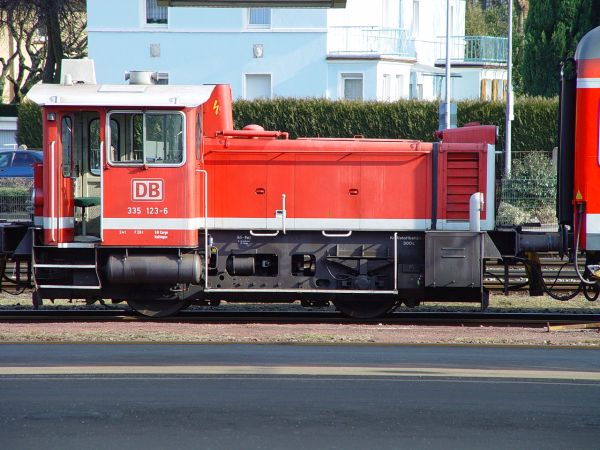
Baureihe 335 is the very latest series of German so called Köf locomotives. Köf means Kleinlokomotiv, ölgefeuert, Flüssigkeitsbetriebe, in English
small locomotive, powered with (diesel) oil, hydraulic. The very first Köf machines were built already before World War II. During the war the
German army ordered large numbers of them more, because as these small machines were not producing huge smoke clouds like the steam locomotives did,
they could more easily operate even close to the enemy lines without being noticed. But the design proved to be extremely successful and long-lived.
A lot of Köf II and Köf III locomotives were built still in the 1960s and 1970s. Köf III locomotives are normally in Germany put in the series Br333,
but this Br335 is a modernised Br333 with the added possibility of remotely controlling the locomotive via radio controls. Br333 machines began to
be modernised and converted to Br335 since 1988.
Picture from Osnabrück 28.2.2003 by Ilkka Siissalo.
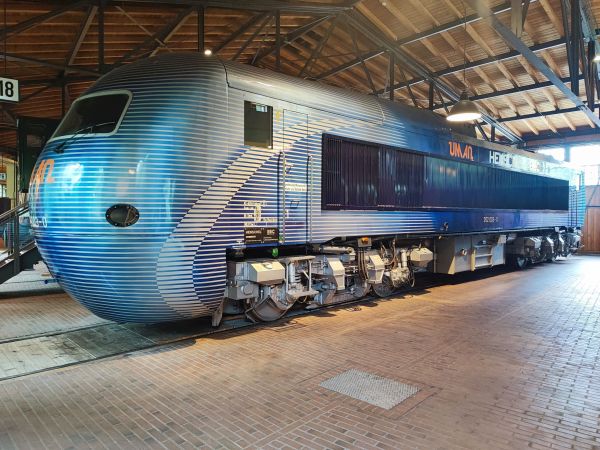
This is a very famous prototype locomotive. Henschel built 1971-74 three prototype large diesel locomotives which were given the Baureihe name Br202.
Henschel called them DE2500. Some of the prototypes had six axles and were intended for heavy cargo trains. This one, BR 202 no. 003 got special bogies
with just four axles and the name UmAn. It was built for a maximum speed of 250 km/h and therefore it got also a special aerodynamic front shape. DB never bought these
prototypes, nor were they ever built in series, but a lot of important lessions were learned. These prototypes were also the precursors of the Danish
large diesel class ME.
Picture from a technical museum in Berlin by Markku Salo 20.6.2023.

